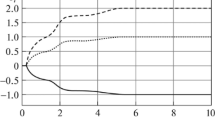Abstract
Primary goal of adaptive observers would be to estimate the true states of a plant. Identification of unknown parameters is of secondary interest and is achieved frequently with the persistent excitation condition of some regressors. Nevertheless, two problems are linked to each other in the classical approaches to adaptive observers; as a result, we get a good state estimate once after a good parameter estimate is obtained. This paper focuses on the state estimation without parameter identification so that the state is estimated regardless of persistent excitation. In this direction of research, Besancon (2000) recently summarized that most of adaptive observers in the literature share one common canonical form, in which unknown parameters do not affect the unmeasured states. We enlarge the class of linear systems from the canonical form of (Besancon. 2000) by proposing an adaptive observer (with additional dynamics) that allows unknown parameters to affect those unmeasured states. A recursive algorithm is presented to design the proposed dynamic observer systematically. An example confirms the design procedure with a simulation result.
Similar content being viewed by others
References
Bastin, G. and Gevers, M. R., 1988. “Stable Adaptive Observers for Nonlinear Time-Varying Systems,”IEEE Trans. Automat. Contr. 33, pp. 650–658.
Besancon. G., 2000, “Remarks on Nonlinear Adaptive Observer Design,” Systems & Control Letters 41, pp. 271–280.
Carroll, R. L. and Lindorfe. D. P., 1973, “An Adaptive Observer for Single-Input Single-Output Linear Systems,”IEEE Trans. Automat. Contr. 18, pp. 428–435.
Kreisselmeier, G., 1977, “Adaptive Observers with Exponential Rate of Convergence,”IEEE Trans. Automat. Contr. 22, pp. 2–8.
Kristic, M., Kanellakopoulos, I. and Kokotovic, P. V., 1995,Nonlinear and Adaptive Control Design. John Wiley & Sons, Inc.
Luders, G. and Narendra, K. S., 1973, “An Adaptive Observer and Identifier for a Linear System,”IEEE Trans. Automat. Contr. 18, pp. 496–499.
Luders, G. and Narendra, K. S., 1974, “A New Canonical form for an Adaptive Observer,”IEEE Trans. Automat. Contr. 19, pp. 117–119.
Marino, R., 1990, “Adaptive Observers for Single Output Non-Linear Systems,”IEEE Trans. Automat. Contr. 35, pp. 1054–1058.
Marino, R. and Tomei, P., 1992, “Global Adaptive Observers for Nonlinear Systems Via Filtered Transformations,”IEEE Trans. Automat. Contr. 37, pp. 1239–1245.
Author information
Authors and Affiliations
Corresponding author
Rights and permissions
About this article
Cite this article
Son, YI., Shim, H., Back, J. et al. An adaptive algorithm applied to a design of robust observer. KSME International Journal 17, 1443–1449 (2003). https://doi.org/10.1007/BF02982323
Received:
Revised:
Published:
Issue Date:
DOI: https://doi.org/10.1007/BF02982323




